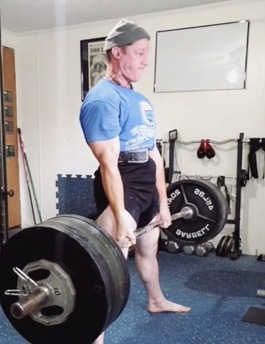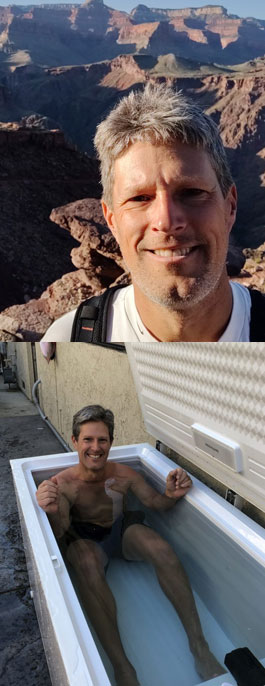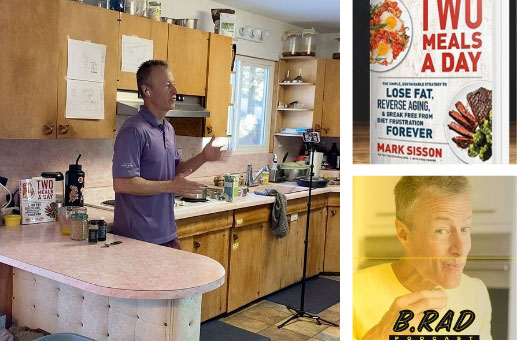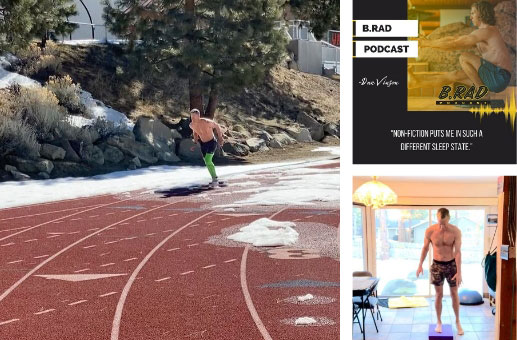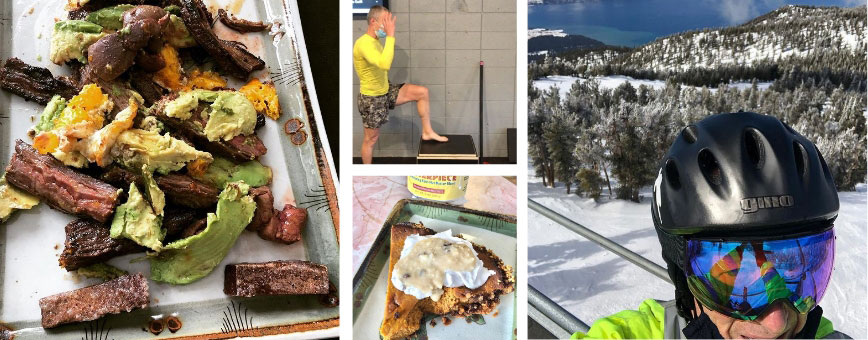In this episode, I call out some dangerous and misguided fitness advice floating around on social media—like a post from a PhD in exercise physiology suggesting that everyone should go run for 45 minutes in 100-degree heat to boost their VO₂ max.
Sure, the science on heat training is interesting and real, but context matters. For elite athletes training for world championships, carefully managed heat exposure can make sense. For the other 99.9% of people, it’s a fast track to burnout, breakdown, or even the ER.
I break down the difference between training stress that builds fitness versus stress that destroys it, explain how to recognize the signs of overtraining, and share why fatigue is feedback, not weakness. I also revisit my critique of Layne Norton’s “push through it no matter what” philosophy and contrast that with what smart athletes actually do—monitor recovery, track readiness, and adjust daily.
To wrap up, I share lessons from my own mistakes, insights from coach Cynthia Monteleone, and why true recovery days sometimes mean actually resting.
TIMESTAMPS:
Brad takes issue with the recommendation that people exercise in 100 degree heat. [01:10]
If you are talking about competitive athletes, rather than the general population, that would be different. [03:30]
Running is too stressful for the vast majority of participants. [06:37]
The main two reasons for poor performance and workouts are one, over training and two, de-training. [10:27]
You are literally training the body to get slower, weaker and less efficient with poor technique when you train and push your body through signs of poor movement patterns. Fatigue is feedback, not weakness. [12:10]
If you don’t feel like working out one day, that is a signal from the control center, your brain. [17:57]
There is a huge distinction between endurance athletes where they always have that obligation to keep that aerobic system going with low intensity recovery days versus a true recovery day for a high intensity power athlete which entails sitting around and resting. [21:41]
LINKS:
- Brad Kearns.com
- BradNutrition.com
- B.rad Superdrink – Hydrates 28% Faster than Water—Creatine-Charged Hydration for Next-Level Power, Focus, and Recovery
- B.rad Whey Protein Superfuel – The Best Protein on The Planet!
- Brad’s Shopping Page
- BornToWalkBook.com
- B.rad Podcast – All Episodes
- Peluva Five-Toe Minimalist Shoes

Check out each of these companies because they are absolutely awesome or they wouldn’t occupy this revered space. Seriously, I won’t promote anything that I don’t absolutely love and use in daily life:
- B.rad Nutrition: Premium quality, all-natural supplements for peak performance, recovery, and longevity; including the world’s highest quality whey protein!
- Peluva: Comfortable, functional, stylish five-toe minimalist shoe to reawaken optimal foot function. Use code BRADPODCAST for 15% off!
- Ketone-IQ Save 30% off your first subscription order & receive a free six-pack of Ketone-IQ!
- Get Stride: Advanced DNA, methylation profile, microbiome & blood at-home testing. Hit your stride the right way, with cutting-edge technology and customized programming. Save 10% with the code BRAD
- Mito Red Light: Photobiomodulation light panels to enhance cellular energy production, improve recovery, and optimize circadian rhythm. Use code BRAD for 5% discount!
- Online educational courses: Numerous great offerings for an immersive home-study educational experience
- Primal Fitness Expert Certification: The most comprehensive online course on all aspects of traditional fitness programming and a total immersion fitness lifestyle. Save 25% on tuition with code BRAD
I have a newly organized shopping experience at BradKearns.com/Shop. Visit here and you can navigate to my B.rad Nutrition products (for direct order or Amazon order), my library of online multimedia educational courses, great discounts from my affiliate favorites, and my recommended health&fitness products on Amazon.
TRANSCRIPT:
Brad (00:00):
Welcome to the B.rad podcast – where we explore ways to pursue peak performance with passion throughout life. I’m Brad Kearns, NY Times bestselling author, world #1 ranked masters age 60-plus high jumper, and former #3 world-ranked professional triathlete. You’ll learn how to stay fit, strong and powerful as you age; transform your diet to lose body fat and increase energy; sort through hype and misinformation to make simple, sustainable lifestyle changes; and broaden your perspective beyond a fit body to experience healthy relationships, nonstop personal growth, and ultimately a happy, healthy, long life. Let’s explore beyond shortcuts, hacks, and crushing competition to laugh, have fun, appreciate the journey, and not take ourselves too seriously. It’s time to B.rad!
Brad (00:51):
The post talks about how heat acclimation is one of the most underutilized 10 days of training in high heat can expand plasma volume, bump up maximal cardiac output, and improve VO O2 max lactate threshold and time trial performance in all conditions. Yes, it’s true, no disagreement there, but,
Brad (01:10):
And welcome to this week’s edition of really crazy Ill-advised social media posts. Here’s one from a doctor of exercise physiology actually has a decent site with a lot of good information, but this one I’m going to have to challenge as he talks about the benefits of heat training. Listen,
Recording (01:40):
2010 studies showed that exercising for 45 minutes <inaudible> could increase V O2 max and lactate threshold by up to 8%, while thermo neutral train counterparts showed no significant differences. For context, the landmark altitude study in 1997 showed changes of only 5%. These changes were derived primarily by an increase in plasma volume and cardiac output. Go put some sunblock on and take in these record hats. <laugh>, although for more running science, Pete training really is poor man. Let’s hear
Brad (02:10):
The first part again.
Recording (02:11):
Study showed that exercising for 45 minutes in 100 degree Fahrenheit weather could increase V O2 max and lactate threshold by up to 8%
Brad (02:20):
Exercising for 45 minutes in 100 degree Fahrenheit temperatures can improve your V 02 max and lactate threshold. Okay, look, first of all, a general post to the general social media audience or to your followers or to your algorithm recommending that people exercise for 45 minutes in a hundred degree Fahrenheit seems like a ridiculous recommendation. And not just silly, but potentially destructive. And I’m gonna talk about one of my comments, one of my messages I got from my recent post about Layne Norton’s fitness advice shortly, but here to generally present this scientific research with a cute little admonition at the end to put on the sunblock and get out there and enjoy and experience those record temperatures is really off base for the average fitness enthusiast. 99.9% of people looking at this real, uh, and <laugh>, first of all, look who we’re seeing in the B roll.
Brad (03:30):
We saw Elwood Kipchoge, I believe there’s Galen Rupp and Bernard Legatt, two of the greatest, uh, American distance runners of all time. There’s the goat of all time Kipchoge. He can do whatever he wants and train in whatever temperatures he’s gonna benefit from. There’s run going downhill and uh, for the elites, sure, these guys have to prepare for crazy conditions. We just had the world championships in Tokyo, hot steamy, Tokyo weather, and Cole Hawker with the sensational 5,000 meter victory talked about. How’d you prepare for this? Well, they went out in the heat of the day in southern Virginia where he’s based and trained all summer, and he also did sessions with extra clothing where he told his, uh, interview on C mag, I believe he said, I soak through numerous sets of clothes every single day to trigger those sweat mechanisms and make yourself uncomfortable, thereby acclimating to the crazy heat where you are racing for world championship gold.
Brad (04:27):
So if you two are watching and thinking of, uh, bagging some of those medals at the next world championships, yes indeed, try to go out there and train in a hundred degree heat for 45 minutes if you’re planning to race in hot temperatures. Otherwise, what we are talking about here is the general big picture challenge of athletic training, which should be the total emphasis on balancing stress and rest. And there are many ways to stress yourself. One of them is through heat training. He also talked in the post and in the recording, how heat training is similar to altitude training where, uh, the lack of oxygen forcing you to breathe harder, work harder, your body is stimulated to produce more red blood cells. And when you become competent in training a hundred degree temperature heat, yeah, it’s a lot more difficult than training in 60, 70 or 80 degree heat.
Brad (05:26):
So you trigger all these stress-related adaptations. But what we should also mention that don’t have time for in a quick reel is that the stress side of the scale gets heavily weighted when you deliberately go out there as a sub- elite level athlete and put your body into that torture of exercising for 45 minutes straight in a hundred degree heat. And therefore this is gonna require a lot of downtime to recover hormonally, metabolically, your actual body temperature and your homeostatic drives after the workout. It’s gonna take a while and it’s gonna be excessively stressful to the extent that if this is your pattern that you watch real and then go out there and delay your morning run in the hot temperature months from your usual 6:30 AM till 2:00 PM in the name of improving your V 02 max by 8%. Uh, look, this is a recipe for breakdown, burnout, illness, and injury, which is the number one challenge for the average recreational runner.
Brad (06:37):
Mark Sisson and I spent an entire book talking about how running is too stressful for the vast majority of participants. The actual human running gait will typically elevate one’s heart rate beyond fat max heart rate. That’s the maximum fat burning calories per minute and into these slightly to significantly stressful heart rate zones such that you tend to emphasize glucose burning over fat burning. Once you exceed fat max heart rate, you start burning a significantly greater percentage of glucose instead of fat. And this is a characteristic of a more stressful workout rather than a stimulating rejuvenating session where you’re in those comfortable fat burning zones. What does heat do to your training-heart rate? It skyrockets your training heart rate. So the recommendation to exercise 45 minutes in a hundred degree heat for almost everyone watching means that you’re going to change from a typical jog to a walk and not even a brisk walk, perhaps a medium walk or a slow walk in order to maintain an appropriate heart rate, to call it an aerobic aerobic stimulation, proper aerobic stimulation training session.
Brad (07:58):
So let’s factor in everything rather than citing science. Again, I think in the wrong way to say, Hey, training adaptations are observed when athletes train in extreme heat. The post talks about how heat acclimation is one of the most underutilized 10 days of training in high heat can expand plasma volume, bump up maximal cardiac output and improve V 02 max lactate threshold and time trial performance, uh, in all conditions. Yes, it’s true, no disagreement there, but we have to add to the sentence, if you can survive 10 days of training in high heat or you can fill in high elevation. When I was a teenage runner, high school, college, they had these running camps up in the mountains where you’d go for one, two, or three weeks and just put the hammer down and it was a great way to skyrocket your fitness in a short time.
Brad (08:55):
I never went because I was too intimidated because going up there and putting in, let’s say twice as many weekly mileage as you’re accustomed to because you’re up there at camp, there’s nothing else to do. You run twice a day, you’re in the mix with other devoted runners and you have an easy way to overdo it and get into an over-training spiral pattern. I did have occasions of devoted training camps when I was a triathlete with other triathletes. We went up to the mountains, Lake Tahoe, wherever, and we hit it hard for a week or two or three weeks. Everything feels great at the time, often. And then when you spin out of devoted Rocky Balboa training camp, that’s when you sometimes have to pick up the pieces in the form of recovering from over training or injuries or inflammation patterns that lead to injuries.
Brad (09:45):
And this is in a great way to go and push yourself and overdo it. So my comment back, this is a really stupid post. I’m sorry I was so mean. The reply said maybe, which was pretty credible. So next time I’ll be a little softer with my words, although as I remind you, before I publish my one-hour-long take down of Layne Norton’s advice, I did direct message him and say, look man, this is what do you have to say for this? ’cause I think it’s terrible, didn’t answer me. So I put the hammer down and that’ll be my mode going forward. I wonder if you can get sued when people end up in the ER after exercising in a hundred degree heat for 45 minutes. Not joking there, really. And then I say, stress is stress.
Brad (10:27):
You have to manage it carefully. Exercise in a hundred plus might be necessary for the athletes in the real training for gold medals, but in real life, I’m not sure this is a good idea. Okay, I ended, kind of polite there. I talked about Layne Norton, so let’s jump over to remind you of the Instagram post that I did about him, going for those heavy weightlifting sessions and talking about how he was feeling so terrible in training. But his philosophy is to push through and he compared training to the stock market. Just keep investing no matter how you feel astute investors, the recommendation is to keep investing through the market ups and downs because you’re going for that long-term payoff. So that’s very sound investment advice, but I write in the post that your body is not the Dow Jones.
Brad (11:19):
There’s always a reason for feeling crappy moving, really crappy. These are quotes from Layne in his post about how he has to push through it. There’s always a reason. And the main two reasons for poor performance and workouts are one, over training and two, de-training. De-training is pretty obvious to identify, right? You go on your three week cruise for the family summer vacation, you don’t get a chance to work out much. You come back and you put the pin into the weight machine and you can’t do your usual number of reps or you head out for a training session and your pace is much slower and it feels much more difficult. De-training is obvious. Coming back from an illness, like the global pandemic putting you down for seven days or eight days, you’re gonna have some quote, really crappy workouts coming back.
Brad (12:10):
That’s why you always wanna come back gently and gracefully and gradually and not push yourself just ’cause you’ve missed a week of training. But that’s the obvious reason. And the second reason, which is a little more nuanced and confusing, especially to highly motivated driven peak performers, is when they have really crappy workouts or a string of really crappy workouts and wonder why or worse yet, ignore these warning signs from the body and continue to push on. The reason is general overstress patterns in life, most likely overstress patterns from recent workouts. But you can also perform poorly in training because you’re having a long-term family crisis, or your boyfriend’s being a real asshole to you for weeks on end. And that will definitely affect your workout performance. We have to consider all manners of life’s stress on the same side of the scales of justice as we’re trying to always balance stress and rest.
Brad (13:13):
So when you have even the slightest indication of suboptimal performance or suboptimal movement patterns, you have to pay very close attention and back off. There is no other rational recommendation. Pushing through is a huge disastrous mistake. And I had to give Layne a lot of grief here because he’s got a million freaking followers. And it’s, again, it’s not just fun and games, it banter that you can take it or leave it. It is actually hugely destructive to devoted followers looking for wonderful guidance from our fitness leaders, especially those who are obsessed with science and tear apart many other internet influencers for not being devoted and rigorous with their science. And then Layne goes and pops off saying that the body is like the stock market. You have to keep investing no matter what. When you do so <laugh>, what you are doing is you are teaching your central nervous system to fire the muscles less powerfully and less explosively, less efficiently.
Brad (14:20):
You are literally training the body to get slower, weaker and less efficient with poor technique when you train and push your body through signs of poor movement patterns. So I’m saying elite athletes don’t ride the wave of random bad sessions. They monitor recovery, track readiness, and adjust intensity daily. The key takeaways from my podcast talking about Layne”s, bad advice, fatigue is feedback, not weakness. Central nervous system, stress needs deloading and resting time. Smart athletes train with precision, not ego. Stop treating your workouts like Wall Street bets. Respect recovery, maintain perfect form, adapt to your body’s signals. That’s how you stay strong for years and not just weeks. And I was having a conversation with, oh, if you’re watching on the screen, there’s the commenter Fast over 40. That’s none other than Cynthia Monteleon world champion in track and field and coach to numerous world champion level masters, track and field athletes, as well as Olympic athletes.
Brad (15:26):
She says, uh, you know how I feel about all this? And we were just talking earlier today about how, um, some of these people who are not in the master’s category, age groups, I don’t want to hear about any longevity advice from someone who’s in their thirties or forties or I wanna take it with a grain of salt because they’re spouting off on research or whatever, or they’re making recommendations like pushing through fatigue. And you know what, when you’re in your twenties, thirties, whatever, you can possibly get away with this stuff, even though it’s a terrible idea for an elite athlete in their twenties to push through fatigue and poor performance, they’re not gonna have such a severe penalty. As someone, for example, in my age group, the 60 plus when I make a mistake in training, when I tweak a hamstring from doing one too many reps, I am paying the price for weeks and weeks and just so I don’t sound too high and mighty.
Brad (16:20):
I have to relate that last summer, I stepped up to the hexagonal deadlift bar and I was not properly warmed up. I just got out of a car ride of 20 minutes, I’d finished a sprint workout, I figured, hey, I was still pumped up, still feeling good. So I stepped up to the bar and on my, like my second rep, I could feel that lower back go zz. Stupid. I should have warmed up with lightweight, as we always know to do, especially when we’re dead lifting. And that little tweak, that little, uh, tightness that I felt that grabbing took 12 weeks to recover from. So compare and contrast, I made a slight mistake, just lame to not warm up carefully. And I paid the price for three months, and then I go back and scroll on social media with my free time.
Brad (17:07):
And I see some of the leading influences in the world saying training the body is like the stock market. You have to keep investing no matter what. So here, I’m doubling down on my extreme criticism of that in hopes that it will weigh nicely. Here’s a funny one. When I clicked on the, um, the link over to Layne Norton’s, 1 million followers Instagram account, here’s what I get. Live, live shot people. Sorry, this page isn’t available. They took his countdown. Ho did I make a huge impact? And the Instagram, powers that be said, yeah, let’s take this guy down. He can’t tell people to push through fatigue. That’s silly, eh, probably some other reason. Who knows. And then it says, uh, Dr. Layne Norton, new account starting from scratch. I hope you’re giving out good advice, man. Looks like a little bit more varied with these old pictures of bodybuilding and so forth.
Brad (17:57):
Anyway, that’s my, that’s my comment on that. So I hope you can appreciate posts like these. Of course, they’re trying to convey scientific information and it is interesting from an academic setting to go, oh, okay. So heat training stimulates profound physiologic adaptations, as does altitude training, as does any kind of training. But if you’re not sensible and don’t balance it carefully, you are going to be H-O-S-E-D hosed. You will not improve. You will struggle, you will struggle and you will break down. Lemme know what you think in the comments. Thanks a lot for watching and listening and carefully considering your training decisions, bringing in that intuitive element. Also, if you don’t feel like working out one day, that is a strong and powerful signal from the control center, the brain that maybe we need to back off a little bit. I’m still a work in progress learning it myself, right?
Brad (18:56):
I mean obviously anytime I report a little minor injury, I go back to the drawing board, I take notes and I say, I guess I overdid it even though I didn’t think I was overdoing it at the time. Now I can review my training diary and realize that, yeah, I kind of pushed it pretty hard in September and it was not a sensible progression from what I was doing June, July and August. And on that note, I strongly recommend keeping some form of training diary. It doesn’t have to be a robotic regimented, posting all your workouts on Strava. And that’s way past my time as an old school person with a spiral notebook. Here, let me hold up and demonstrate eh, spiral handwritten notebook. I also use the notes program on Apple devices so it can transfer over to my laptop from my phone, when I’m putting in workout details.
Brad (19:47):
And so of course I will recite the number of reps and the times and the weights and whatever, but also putting in some of those subjective comments like, right knee still feels a little tight. And, six hours later after getting up from a long sitting, it was tight again. Uh, take note of that and continue this dialogue. Throughout my training career. I’ve kept a training diary since, let’s see, started in high school running. I think I got the Jim Fixx The Complete Book of Running, the red color, the distinctive red color, you old time runners know what I’m talking about. So I started filling up annual diaries in 1979. How many years is that? Oh my gosh, it’s like half a century of training diaries. And it’s really helpful. Not that I need to show anyone or do shows on it, but, I do show my coaches, advisors like Cynthia Monteleon, she reviews it and will make comments that are really enlightening to me, that it’s hard to see outside of myself sometimes.
Brad (20:46):
One, a huge one that has really changed my approach to my sprinting and jumping career. My high intensity, , athletic career here, making that transition from longtime endurance athlete was I sent her my training diary and she challenged these entries like, Thursday: easy bike ride one hour to farmer’s market and back, recovery day. Friday went to the track, sprinted. Did four times, 200 and four times 100. And she says, what’s this on Thursday? What do you mean? And I said, oh, yeah, my recovery day. She goes, that’s not recovery for a sprinter. A sprinter has to recover those tendons with complete rest rather than an endurance mentality, an endurance athlete mentality that your easy day, your recovery day is an easy spin of the pedals on the bicycle. Now I wanna explain that if you do something that is comfortably paced enough, you can put it into the category of movement.
Brad (21:41):
And the more movement we get, the better it will indeed help recover from, let’s say, high intensity activity like basketball games or heavy duty weight training sessions or sprint workouts. So heading out for a leisurely walk around the block would be my ideal protocol as a sprinter and a high jumper to recover. And indeed take a lot of days where I’m just sitting around and not working my heart and not working my muscles and not doing anything to my tendons except resting them. And that was a huge breakthrough requiring a change in philosophy from my long time, highly programmed endurance mindset that a recovery day, you gotta get out there and put in some time, put in some energy, put in some hours at low intensity to build that endurance space. So huge distinction between endurance athletes where they always have that obligation to keep that aerobic system going with low intensity recovery days versus a true recovery day for a high intensity power athlete, which can actually entail sitting around and resting.
Brad (22:48):
I really appreciate that insight from Cynthia. That’s why I’m sharing it with you. Especially if your goals tend in the area of high intensity anaerobic power, sprinting, strength training. And if you don’t have any distinct athletic goals, look, we want to build competency on all levels of fitness, especially if the main goal is longevity. And so that’s that aerobic competency as well as preserving muscular strength and power and also sprint competency as we age with the emphasis and the priority being on doing that high intensity exercise because it’s often neglected, especially by people in the older age groups with general fitness goals. They’re really good about getting out the door and walking every day or going to the gym and getting on the stairs and watching CNN for 45 minutes and going home or even doing an aerobic based group exercise class with the bars or the steps or the spinning bikes.
Brad (23:45):
But a huge neglect is in the area of explosive high intensity exercise. And as we know from exercise physiology, the anaerobic system responds to high intensity, low frequency, and extensive rest, the opposite of how the aerobic system responds, high volume, high frequency, and low intensity. So a note for all of us, get out there, perform some sprint workouts. You can even do those in the heat. I did an Instagram post saying, Hey, it’s almost a hundred here, and I don’t care because my efforts are only 20 seconds. I’m not getting into this huge thermo regulatory stress as recommended in the post to go exercise for 45 minutes, continuous in the heat. Huge difference from going out there and busting out when it’s nice and warm and your muscles are warm and you’re done before you get the brain overheated and the muscles and the whole, uh, cardiovascular system. So there you have it. Thanks for watching. I hope you enjoy those tips and look forward to engaging on the comments.
Brad (24:51):
Thank you so much for listening to the B.rad podcast. We appreciate all feedback and suggestions. Email podcast@bradventures.com and visit brad kearns.com to download five free eBooks and learn some great long cuts to a longer life. How to optimize testosterone naturally, become a dark chocolate connoisseur and transition to a barefoot and minimalist shoe lifestyle.



